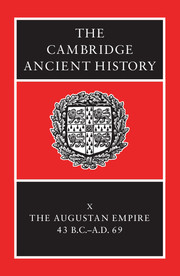21 - Early classical private law
from PART IV - ROMAN SOCIETY AND CULTURE UNDER THE JULIO-CLAUDIANS
Published online by Cambridge University Press: 28 March 2008
Summary
With the establishment of the Augustan Principate, Roman private law enters its ‘classical’ period. During the largely tranquil centuries that followed, Rome's jurists articulated and developed a body of law that is beyond doubt the most conspicuous and influential Roman contribution to Western civilization. This chapter does not describe the system of Roman law itself, but instead concentrates on the jurists and the Roman judicial system during the Julio-Claudian and Flavian eras.
THE JURISTS AND THE PRINCIPATE
Classical Roman law is based upon a distinctive procedural system, called formulary procedure. Formulary procedure, like most other well-developed procedural systems, distinguishes between justiciability (iurisdictio), the judicial determination that a plaintiff is stating a legally acceptable cause of action, and adjudication (iudicatio), the hearing and resolution of the plaintiff's claim. However, formulary procedure radicalizes this distinction: the trial is divided into two stages decided by separate persons.
At Rome, almost all suits between citizens were raised initially in the court of the urban praetor, an annually elected magistrate. The Praetor's Edict listed those causes of action that he was willing to accept during his term of office, as well as the general procedure to be followed in his court; already by the late Republic, the contents of the Edict varied little from year to year. If, in a given case, the plaintiff stated an acceptable cause of action, the praetor assigned a judge (iudex), or in some cases multiple judges, to hear the case; the iudex was usually a layman acceptable as an arbiter to both sides.
Keywords
- Type
- Chapter
- Information
- The Cambridge Ancient History , pp. 959 - 978Publisher: Cambridge University PressPrint publication year: 1996
References
- 10
- Cited by



